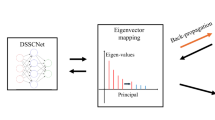Abstract
Dimensionality reduction techniques are commonly used for image recognition. We propose a graph steered dimensionality reduction method called Discriminative Projections based on Collaborative Representation (DPCR) by transforming the dimensionality reduction task into a graph embedding framework. DPCR utilizes the collaborative representation to construct within-class and between-class graphs. To improve the discriminative performance of dimensionality reduction, DPCR introduces the label information into graph building. The novel method not only avoids the difficulty of finding proper neighborhood but also inherits the merits of manifold learning methods and the robustness of collaborative representation techniques. Experiments on benchmark datasets demonstrate its effectiveness.






Similar content being viewed by others
References
Belkin M, Niyogi P (2001) Laplacian eigenmaps and spectral techniques for embedding and clustering. Adv Neural Inf Proces Syst 14(6):585–591
Cox MAA, Cox TF (2008) Multidimensional scaling. Springer, Berlin Heidelberg
Cui H, Zhu L, Cui C, Nie X, Zhang H Efficient weakly-supervised discrete hashing for large-scale social image retrieval. Pattern Recogn Lett. https://doi.org/10.1016/j.patrec.2018.08.033
Gui J, Sun Z, Jia W, Hu RX, Lei YK, Ji S (2012) Discriminant sparse neighborhood preserving embedding for face recognition. Pattern Recogn 45(8):2884–2893
He X (2003) Locality preserving projections. Adv Neural Inf Proces Syst 16(1):186–197
He X, Cai D, Yan S, Zhang H (2005) Neighborhood preserving embedding. IEEE Int Conf Comput Vision, Beijing, China: 1208–1213
Lai J, Jiang X (2014) Discriminative sparsity preserving embedding for face recognition. Int Conf Image Process: 3695–3699
Li Z, Nie F, Chang X, Yang Y (2017) Beyond trace ratio: weighted harmonic mean of trace ratios for multiclass discriminant analysis. Trans Knowl Data Eng 29(10):2100–2100
Liu X, Xu Q, Chau T, Mu Y, Zhu L, Yan S(2018) Revisiting jump-diffusion process for visual tracking: a reinforcement learning approach. Trans Circ Syst Video Technol 8(3):38–49
Liu X, Xu Y, Zhu L, Mu Y (2018) A stochastic attribute grammar for robust cross-view human tracking. Trans Circ Syst Video Technol 28(10):2884–2895
Lu G, Tang G, Zou J (2016) Spare L1-norm-based maximum margin criterion. Visual Commun Image Rep 38:11–17
Lu X, Zhu L, Cheng Z, Song X, Zhang H (2019) Efficient discrete latent semantic hashing for scalable cross-modal retrieval. Signal Process 154:217–231
Luo M, Chang X, Li Z, Nie L, Hauptmann AG, Zheng Q (2017) Simple to complex cross-modal learning to rank. Comput Vis Image Underst 163:67–77
Ma Z, Chang X, Xu Z, Sebe N, Hauptmann AG (2018) Joint attributes and event analysis for multimedia event detection. IEEE Trans Neural Netw Learn Syst 29(7):2921–2930
Nie L, Wang M, Zha ZJ, Chua TS (2012) Oracle in image search: a content-based approach to performance prediction. Trans Inform Syst 30(2):1–23
Nie L, Song X, Chua TS (2016) Learning from multiple social networks. Synthesis lectures on information concepts retrieval and services, Morgan Claypool, USA
Qiao L, Chen S, Tan X (2010) Sparsity preserving projections with applications to face recognition. Pattern Recogn 43(1):331–341
Roweis ST, Saul LK (2000) Nonlinear dimensionality reduction by locally linear embedding. Science 290(5500):2323–2326
Sakai H, Liu C, Nakata M (2016) Information dilution: Granule-based information hiding in table data - A case of lenses data set in UCI Mach Learn repository. International Conference on Computing Measurement Control and Sensor Network, Matsue, Japan: 52–55
Tenenbaum JB (1998) Mapping a manifold of perceptual observations. Adv Neural Inf Proces Syst: 682–688
Turk MA, Pentland A(1991) Face recognition using eigenfaces. Computer society conference on computer vision and Pattern Recogn: 586–591
Wang Y, Zhang H, Yang F (2017) A weighted sparse neighborhood-preserving projections for face recognition. J Res 63:358–367
Wang Q, Gao Q, Xie D, Gao X, Wang Y (2018) Robust dlpp with nongreedy ℓ1-norm minimization and maximization. IEEE Trans Neural Netw Learn Syst 29(3):738–743
Xie L, Shen J, Han J, Zhu L, Shao L (2017) Dynamic multi-view hashing for online image retrieval. Int Joint Conf Artif Intell: 3133–3139
Yang J, Chu D (2010) Sparse representation classifier steered discriminative projection. International Conference on Pattern Recognition, Istanbul, Turkey: 694–697
Yang J, Chu D, Zhang L, Xu Y, Yang J (2013) Sparse representation classifier steered discriminative projection with applications to face recognition. Trans Neural Netw Learn Syst 24(7):1023–1035
Yang W, Wang Z, Sun C (2015) A collaborative representation based projections method for feature extraction. Pattern Recogn 48(1):20–27
Zhang H, Lu J (2009) Semi-supervised fuzzy clustering: a kernel-based approach. Knowl-Based Syst 22(6):477–481
Zhang L, Yang M, Feng X (2011) Sparse representation or collaborative representation: which helps face recognition? International conference on computer vision, Barcelona, Spain, November ,pp 471–478
Zhu L, Huang Z, Li Z, Xie L, Shen H T (2018) Exploring auxiliary context: discrete semantic transfer hashing for scalable image retrieval,29(11):5264–5276
Acknowledgements
The work is supported by the National Natural Science Foundation of China (No.61702310 and 61772322), the Key Research and Development Foundation of Shandong Province (No. 2016GGX101009).
Author information
Authors and Affiliations
Corresponding author
Additional information
Publisher’s note
Springer Nature remains neutral with regard to jurisdictional claims in published maps and institutional affiliations.
Rights and permissions
About this article
Cite this article
Liu, L., Zhang, B., Zhang, H. et al. Graph steered discriminative projections based on collaborative representation for Image recognition. Multimed Tools Appl 78, 24501–24518 (2019). https://doi.org/10.1007/s11042-018-7117-8
Received:
Revised:
Accepted:
Published:
Issue Date:
DOI: https://doi.org/10.1007/s11042-018-7117-8




